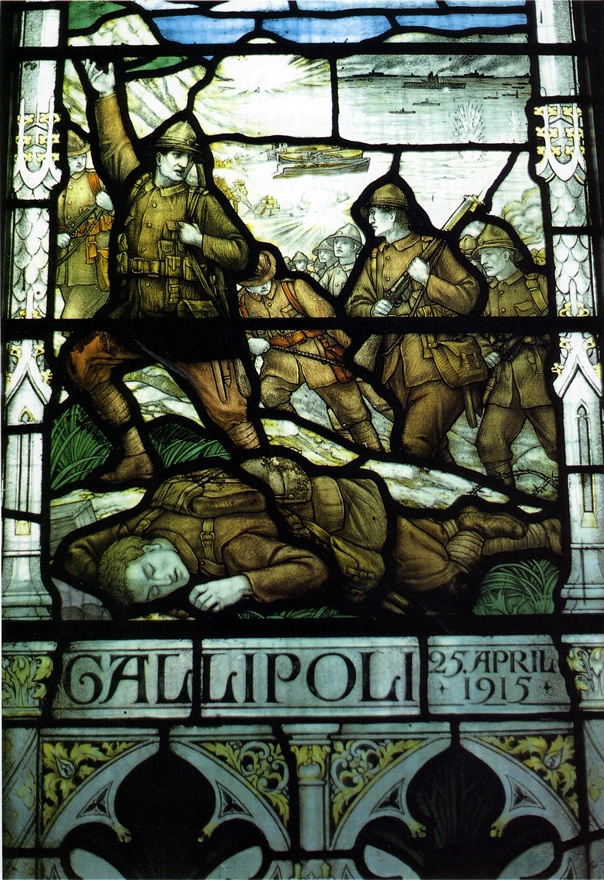
St Andrew’s Anglican Church, Cambridge, is known for its fine sets of war memorial windows.
The First World War memorial windows in the eastern transept were unveiled by Governor-General Viscount Jellicoe on 11 December 1923. The left-hand lancet includes a figure representing Truth and a depiction of the landings at Gallipoli on 25 April 1915; the central lancet includes the figure of ‘Freedom’ and a soldier kneeling before a wayside crucifix outside the ruined city of Ypres; the right-hand lancet includes the figure of ‘Justice’ and shows New Zealand soldiers storming the walls of Le Quesnoy on 4 November 1918. The roll of honour beneath the windows was dedicated on Anzac Day 1929. It incorporates a central dedicatory plaque (‘TO THE GLORY OF GOD / AND IN MEMORY OF / THESE MEN WHO GAVE THEIR LIVES IN THE CAUSE OF / TRUTH, FREEDOM, AND JUSTICE / IN THE GREAT WAR, 1914 – 1918. / Remembering these dead let the living be humble’) and individual brass tags listing the names of 42 men.
The equally impressive Second World War memorial windows in the opposite transept were dedicated by the Bishop of Waikato, the Reverend J.T. Holland, on 6 December 1953. The three lancets are dedicated respectively to the New Zealand Army, Royal New Zealand Navy and Royal New Zealand Air Force. The names of 19 men are listed on the roll of honour below.
Alongside the First World War memorial windows is a painting of the storming of Le Quesnoy and a plaque honouring Lieutenant-Colonel L.M. Blyth. These were presented to the church when an official delegation from Le Quesnoy visited Cambridge in February 1997 (Lieutenant-Colonel Blyth was by then the only living veteran of the siege).
St Andrew’s contains a number of other memorials of military significance. Pictured here are the two New Zealand Wars memorial hatchments which were unveiled on 7 May 1914. These were dedicated respectively to the memory of members of the ‘Imperial & Colonial Forces’ and ‘The Friendly Maoris’ who died during the 1860s. Not pictured here are the following items: the reredos (screen behind the altar), which was originally installed as a South African War memorial in 1900, but has been much altered since; a memorial window in the transept dedicated to the Reverend Clive Mortimer-Jones, who was vicar of the parish from 1912 to 1926, and served as a chaplain to the 25th Reinforcements; two garden seats installed outside the church in September 1949 in memory of Flying Officer Leslie Buttimore and Pilot Officer William Hewitt; a small brass plaque inscribed, ‘Waikato Mounted Rifles / in memory of those from this district / who lost their lives in active service / and in honour of all those who served’; and Regimental Colours and other relics inherited by the 2nd Armoured Squadron (Waikato) RNZAC and laid up on its amalgamation in October 1970.
St Andrew’s parish hall, opened alongside the church in 1931, was originally intended to serve as a peace memorial, but there is no record that it was ever dedicated as such.
Sources: ‘Hatchments Unveiled’, Waikato Independent, 9/5/1914, p. 5; ‘Memory of the Fallen: Memorials to Soldiers: Unveilings at Cambridge’, NZ Herald, 12/12/1923, p. 13; ‘Day of Remembrance’, Waikato Independent, 27/4/1929, p. 4; Lilian M. Hanton and George N. Marshall, Parish of St Andrew’s, Cambridge: Centennial Chronicle, 1871-1971, Cambridge, 1981, pp. 18, 20, 26, 32, 34-6; Lilian M. Hanton, St Andrew’s: Our Heritage, Cambridge, 1981; Margaret Vosper and George Marshall, Church at the Cross Roads, 1871-1996: Parish of St Andrew’s Cambridge, Cambridge, 1996, pp. 12-14, 16-18; A Stong Sense of Duty: The First World War Letters of Chaplain The Reverend Clive Mortimer Jones, 1917-1920, ed. Herbert H. Farrant, Elizabeth Morey and Delysse Storey, Auckland, 2013, pp. 137-43.







Community contributions